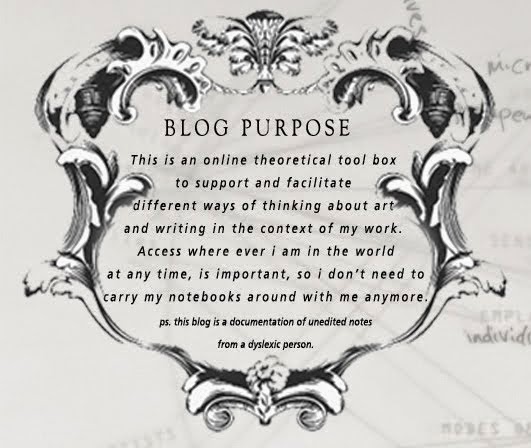Clare Bishop Artificial Hells
Participatory art and the politics of spectatorship. This
book is not about transdisciplinery research based activist interventionists
and people as mediums.
The main aim of the
book: is to show the inadequacy of a post-activist sociological approach to
participatory art, as proposed for cultural policy, think tanks studies, that
focus on demonstraitable outcomes. To reinforce the need to keep alive the
constitutively undefinitive reflections
on quality that characterises the humanities.
Participation: is
active involvement as apposed to passive consumption passive observation. It is
a strategy among many that can be placed in particular contexts for specific
outcomes. Jaques Ranciere suggests participation as an unpredictable subject
that occupies the street, gallery, museum. Artists work with participation for:
(I have added my own thoughts to this list too)
1.
aesthetic experience is found at every centre.
2.
The only remaining theatre action is direct
3.
Engagement with the forces of production
4.
Loss of studio space- pushes creativity in other
mediums.
5.
The need to get out of isolation of the studio.
6.
Not having a gallery space to show work.
7.
Being forced to rethink how to produce work or
be creative.
8.
The need to communicate with the wider world.
9.
To rehumanise reconnect empower and repair
social bonds.
10. To
decide to make an impact about something imporatant.
Openendedness –
is a radical refusal of criticism. (a utopian ideal for me)
Hierarchy:
Quality is often contested in participatory art, rejected by
many curators who serve powerful elites. Bishop declares the assumption that
value judgements are necessary not as a means to reinforce elite culture and
police the boundaries of art and non-art, but as a way to understand and
clarify our shared values at a given historical moment.(p8) There is no fixed recipe
for good art authorship.
Bathes quote: “Authorship of all kinds are multiple and
continually indebted to others, what matters are the ideas, experiences,
possibilities, results from the interactions”
The books key themes: quality and equality, singularity and
collective authorship, artists political position, education and therapy,
Live encounters -
Process-based experiences -
Intersubjective exchange -
Greengergian narrative -
Instruction based –
Stage provocations -
Intersubjective
exchange – a philosophical term. shared ideas to shape relations by more
than one conscious mind.
an
Intersubjective perspective - in psychoanalysis means, above all, to give
up what Robert Stolorow and George E. Atwood define as
"the myth of isolated mind."[
Intersubjective
exchange with theatre and performance, theatrical innovations, a farm of
soft engineering, community art based genre.
Interactivity - one-to-one
Participatory –
many people
Post studio practice
– is also socially engaged Art, community-based art, experimental communities,
dialogic art, littoral art, interventionist art, participatory art,
collaborative art, contextual art, and social practice.
Clare sees participatory artists as producers of situations.
Impromptu occurrences Now, the viewer or the beholder is a co-producer or
participant.
Historic background
to participatory practice. P3
Popular mass audience of the futurist serrate 1910 after the
Bolshevik revolution (a mass demonstration of women workers
in Russia February of 1917, the Czar's
officials called out the army to squelch the protesters but the women convinced
the soldiers to put their guns away and help them in their cause.) 1921 Dada
where Andre Breton took to the street, Paris 1960;s situationist international
a response to consumer capitalism in Europe.
The case studies she uses indicate to
her that participatory art was as a
strategic weapon to spread a means to create a privatised sphere of individual
expression (p4). She proves that participation is not another word for
“collectivism” or opposed to capitalism, but reinforces the political left
doctrine.
There
are three modes of participation:
1.
delegated performance, everyday people are hired
on the behalf of an artist
2.
delegated performance, using professionals from
other spheres of expertise other than art and performance with specific skills corporated
into the performance ready made
3.
situations constructed for video and film.
Issues around this:
exploitation of participants are they included as co-producers and individually
named?
Delegated performance
can be judged as a model for:
1.
social organisation that can be evaluated
according to pre-established moral criteria.
2.
Or as a more productive view of
conceptualisations of performances of “ artistic decisions” to challenge
traditional artistic criteria,
3.
to give visibility to certain social
constitutions and render them more complex, immediate and physically present,
4.
to introduce aesthetic effects of chance and
risk,
5.
to problematize the binaries of live and
mediated, spontaneous and staged authentic and contrived,
6.
to examine the constructions of collective
identity.
By setting up situations that unfold with greater or lesser
degree of unpredictability , artists give rise to a highly directed form of
authenticity.
Singular Authorship:
a highly authored situation whose practice outcomes cannot be foreseen. The
artist both parts with power and reclaims power, the artist agrees to
temporarily lose control over the situation before returning to the select
(abstract expressionist painting – not knowing how its going to turn out, but
still has control).
Connexionist:
project based model, structured by networks, where workers/audience feel
fulfilment and autonomy.
Collective
Authorship: creative negotiation with other people who are essential to the
creative realisation of a given project.

